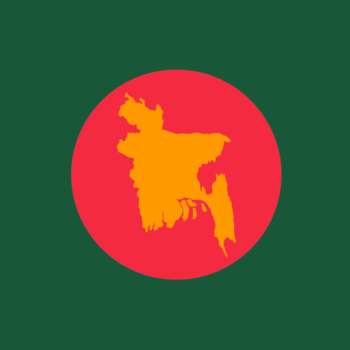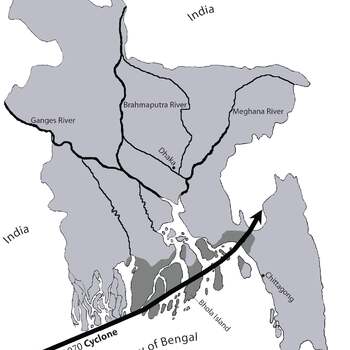Ayub Khan was the second president of Pakistan after seizing power in a coup in 1958.
Language Movement
Language played a key role in the independence movement of Bangladesh and became a key feature in nation-building after the Liberation War against Pakistan. Since the foundation and independence of Pakistan in 1947, language was a key dividing issue in the newly established state. The new Pakistani elite faced a difficult task of uniting all its citizens into a united Pakistani nation, and one immediate question that arose with the new state was about the language that would be used to conduct Pakistan’s state business. The Pakistan Educational Conference of November 1947 proposed Urdu as the national language even though it was spoken by only 3% of Pakistanis, compared to 56% who spoke Bengali. The first population census revealed that Pakistan had 78 million inhabitants, of whom 44 million (55%) lived in East Pakistan. However, the country’s rulers were concentrated in West Pakistan and used Islam to dismiss Bengali’s protests as un-Islamic or anti-Islamic. Students in East Pakistan held meetings and demonstrations and formed the Language Action Committee in December 1947 when they learned about the plans to make Urdu the national language.
East Pakistan, where Bengali was the language spoken by the majority, opposed the move by the founder of Pakistan, Mohammed Aloi Jinnah, to make Urdu the national language. The people of East Pakistan demanded Bengali be made a national language in the Bengali Language movement.
War of Independence
During the 1960s, the regime became even more unpopular among the East Pakistanis as the provincial governor arrested and prosecuted many political opponents and created an atmosphere of fear. These feelings were strengthened as the East Pakistanis realized during the India-Pakistan war over Kashmir in 1965 that there were not that many armed forces that could protect them in the event of an invasion.
In 1966, Sheikh Mujibur Rahman (Awami League) presented a list of demands known as the Six-Point Programme. (This went further than demands made earlier and suggested a confederation of two separate units). The demands were met with government repression and framing of Mujibar. Agitated by the government, the East Pakistanis gave Mujib the name Bongobondhu (Friend of Bengal). During the ensuing years, nationalist sentiment increased and there were moves in both Pakistans to overthrow Ayub’s regime.
An uprising in East Pakistan in 1969 contributed to Ayub Khan's overthrow. Another general, Yahya Khan, usurped the presidency and enacted martial law. In 1970, Yahya Khan organised Pakistan's first federal general election.
Yahya Khan started by bringing politicians back in the equation and promised National Assembly elections at the end of 1970. The majority of the seats were allotted to East Pakistan. The National Assembly was ultimately filled with two large regional parties: the Awami League from the east (the largest party) and the Pakistan People’s Party from the west, headed by Zulfikar Ali Bhutto.
Bhola cyclone
On 11 November 1970, East Pakistan (present-day Bangladesh) and India's West Bengal were struck by the devastating Bhola tropical cyclone. It remains the deadliest tropical cyclone ever recorded and one of the world’s worst ever natural disasters. At least 500,000 people lost their lives in the storm. There was a lot of (international) criticism of the Pakistani junta’s response to the cyclone.
Independence
On 26 March 1971, after Sheikh Mujibur Rahman declared independence on radio, Pakistan launched a crackdown on East Pakistan called Operation Searchlight and declared martial law, which was heard by only a limited number of people due to the broadcasting system used. Sheikh Mujibur Rahman was detained by Pakistan Army soon after.] On 27 March, Major Ziaur Rahman, officer of the East Bengal Regiment, declared the Independence of Bangladesh from Swadhin Bangla Betar Kendra on behalf of Sheikh Mujibur Rahman and called the actions of Pakistan Army a massacre while asking for intervention of the United Nations. On 10 May Bengals members of provincial and national assembly gathered in Kolkata and created a government in exile.[4] It created the Proclamation of Independence which was read from Baidyanathtala in Meherpur District.
The Independence Day of Bangladesh is celebrated on 26 March on the day Sheikh Mujibur Rahman declared the Independence of Bangladesh.
Concert for Bangladesh
In 1971, former Beatles guitarist George Harrison and Indian sitar player Ravi Shankar organized two benefit concerts known as the Concert for Bangladesh. It is regarded as the first ever benefit concert. The proceeds were to go to the victims of both the cyclone and the political unrest (and the genocide).
Secession
East Pakistan seceded, with the help of India due to the India-Pakistani war. The country then called itself Bangladesh, meaning ‘Land of Bengal’ or ‘Country of Bengal’.
Sources and Read More:
van Schendel, Willem (2020). A History of Bangladesh

